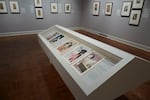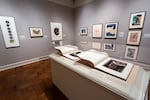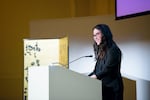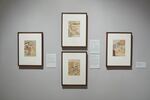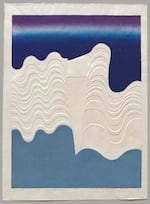
Portland Art Museum appointed Jeannie Kenmotsu as the new Arlene and Harold Schnitzer Curator for Asian Art.
Portland Art Museum / Courtesy
Jeannie Kenmotsu welcomes the excitements and challenges of being Portland Art Museum’s new Arlene and Harold Schnitzer Curator for Asian Art.
“There’s real diversity here of a meaningful kind, not as a buzzword,” she said. “For me ... it means I feel a responsibility and an excitement about bringing some of that forward so that it’s kind of in more public view.”
Kenmotsu was appointed to the position in December; she had been serving as the interim head of Asian art after her predecessor, Maribeth Graybill, retired in 2019.
In 2017 Kenmotsu joined PAM’s staff as Japan Foundation assistant curator of Japanese art and was promoted to associate curator in 2019.
“My predecessor got a really big fantastic grant that is focused on infrastructure at museums, and it’s funded by The Japan Foundation. And it was a five-year grant for a position at the assistant curator level,” she said.
Kenmotsu has extensive knowledge of Japanese art history from what she terms the early modern period.
“So 17th to 19th-century painting, illustrated books, prints in particular,” she said. “This is a moment in Japan when there’s just such an incredible flowering of popular culture. There’s art forms of patronage at kind of every level. And so there’s just so much rich art to study.”
Initially, Kenmotsu went to college planning to study art history, but she switched to English when a lecture she took didn’t resonate with her.
“It turned out to be a great decision, as I had wonderful professors, fell in love with Toni Morrison, and became a better writer,” she said. “Later I took other art history courses which were fantastic, and I did minor in art history in the end.”
While studying abroad at the University of Cape Town, she took a few courses in art history and material culture in South Africa. Those courses, along with living outside the United States, broadened her sense of the world and opened her eyes to the intricacies of non-Western art history, which she found much more interesting.
“So in a funny way, South African contemporary art is what brought me to Asian contemporary art, which is what brought me to historical Asian art,” she said.
When it came time for her post-graduate school dissertation, she wound up focusing on 18th-century Japanese art.
“It’s an odd way to end up doing a dissertation on 18th Century Japanese art, but for me, this was all linked,” she said.
Kenmotsu then received her master’s degree and Ph.D. in art history from the University of Pennsylvania and worked in various arts institutions in New York before joining the staff at the Portland Art Museum.
As the curator of Asian art, Kenmotsu is responsible for maintaining the thousands of pieces in PAM’s permanent collection, which dates back to the founding of the museum. The challenge is how to ensure that the art pieces are properly cared for while giving them the opportunity to be viewed by the public.
“One of the reasons that we have such a big collection and why many museums have big collections is a lot of works are sensitive to light and humidity,” she said. “And so you want to limit their exposure over time. You can’t just keep them up continuously for years.”
Kenmotsu curated a number of exhibits including the highly regarded “Dramatic Impressions: Japanese Actor Prints” in 2019, which showcased woodblock prints of Japanese kabuki actors.

An installation view of the Portland Art Museum’s 2020-21 exhibition "Objects of Contact: Encounters between Japan and the West," curated by Jeannie Kenmotsu. The exhibition opened in late February 2020, shortly before the coronavirus pandemic forced the museum to close.
Portland Art Museum / Courtesy
Her latest exhibits are “Objects of Contact: Encounters Between Japan and the West,” and “Joryū Hanga Kyōkai, 1956–1965: Japan’s Women Printmakers.”
“Objects of Contact” presents works of art and objects that reveal the fascinating history of transnational engagement between Japan and the west for more than three centuries.
“Joryū Hanga Kyōkai,” which translates to Women Printmakers Association, showcases the prints of a collective of female Japanese printmakers from the 50s and 60s, whose work has been somewhat forgotten.
The exhibits came at an unprecedented time for Portland Art Museum. Due to the ongoing COVID-19 pandemic, the museum was forced to shut its doors to in-person visits for the foreseeable future.
As a result, Kenmotsu and the staff had to change the way in which they showcased the collection of art.
“I think the thing that’s been the hardest is the kind of rollercoaster that we’re evolving on, where we think it gets better and then it’s clearly not better at the moment that we think it will. And so you go back to the drawing board and come up with a new set of plans, and just kind of being on that ride,” she said.
But despite not having in-person attendance, Kenmotsu and the staff at PAM found ways to engage the public.
One way was through virtual tours. For “Objects of Contact,” Kenmostu narrated a video tour of the exhibit, and there are currently plans to create a virtual tour for “Joryū Hanga Kyōkai.”
“At least you get those big images and you can really see detail in the work, which would actually be really good for this “Joryū Hanga Kyōkai” show because they’re so surprising,” she said
The virtual tours, along with daily blog posts on PAM’s website, have kept the public aware of the goings-on with the museum and, Kenmotsu hopes, will bring them back once it’s safe to do so.
Response to the exhibits, especially “Joryū Hanga Kyōkai,” have been positive locally as well as around the world, she said.
“I’ve heard from colleagues everywhere from the British Museum, to Cleveland, to all over. Like I said, these artists are lurking in these collections,” she said. “We’re all hungry for something that hasn’t been told before, something that’ll give us a new perspective ... and stories that help us redefine our perspectives on some of those questions, I think are interesting to a lot of people,”
Despite the difficult year, Kenmotsu remains positive and hopeful that one day, people will return to viewing exhibits in person.
“I really appreciate being able to create those moments for people, because I think when you’re surprised and intrigued by something, you’re so much more likely to go look closer,” she said. “So I really hope we can be open and share that again in some form, or at least do it virtually so that you can do it from your couch.”


